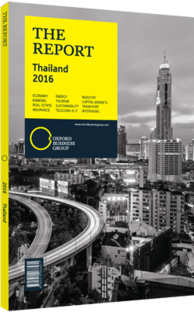Thailand gets new location-specific minimum wage laws
The Thai government is implementing sweeping changes to its labour laws, with the minimum wage to change from a national rate to one dependent on the area, cost of living and localised economy. However, no provincial wages will be set lower than the current national minimum, and Thailand is currently recording some of the fastest wage growth in Asia, putting further pressure on its struggling exporters.
National Minimum Wage
In January 2013 the government implemented a uniform minimum wage of BT300 ($9) per day, drawing criticism from the private sector due to the impact it would have on operating costs and competitiveness, while the government argued it was the best method through which to bolster development of a skilled labour force.
Labour productivity was already relatively high. Thailand was ranked the third most-productive nation out of six Asian economies surveyed in a 2014 report by McKinsey Global Institute, with average annual manufacturing output of $21,200 per worker, behind Malaysia ($33,200) and China ($57,100), but ahead of the Philippines ($16,500), Indonesia ($14,200) and Vietnam ($3800). However, wages in Thailand are also much higher than in many of its ASEAN neighbours, with the International Labour Organisation reporting that in 2013 wages averaged $391 per month, compared to $215 in India and the Philippines, $197 in Vietnam, $183 in Indonesia and $121 in Cambodia.
The wage hike was expected to boost productivity, helping Thailand avoid the middle-income trap that has affected other upper-middle income nations; policymakers argued a national minimum wage would push workers to raise their skill levels, particularly outside Bangkok, helping the country prepare for rising labour competition in the context of ongoing ASEAN Economic Community integration in 2016.
Changes
In June 2015 the permanent secretary of the Ministry of Labour (MoL) announced that the national daily minimum wage would cease at the end of the year. This followed a Wage Committee resolution, unveiled in December 2014, which will see Thailand revert to its former system, in which wages across the country were set depending on the cost of living and the economy in each of the 76 provinces.
Under proposed changes, the Provincial Wage Committees are set to consider the cost of living in each province, and will make recommendations for the appropriate wages. However, a July 2015 article on legal website Lexology noted that while new minimum wages would be set in 2016, no provincial minimum wage will be set lower than BT300 ($9).
Drawbacks
In December 2015 global advisory firm Korn Perry forecast that Thailand would see Asia’s third-highest growth in real wages (adjusted for inflation) in 2016, at 6.1%, behind Vietnam (7.3%) and China (6.1%). Although Thailand’s wage growth is in keeping with regional trends – in Asia it is set to hit a world-leading 4.2% in 2016 – above-average growth will pose a problem for the government as it seeks to boost foreign direct investment inflows, which fell by 78% during the first nine months of 2015.
The private sector, which had already faced wage hikes of up to 70% in some areas following the introduction of the original minimum wage policy, is now facing further challenges, as external pressure has led to three consecutive years of export revenue contraction. Increased labour costs will also affect small and medium-sized enterprises, already struggling in the wake of subdued global demand and a rising debt burden (see Banking chapter). However, in light of prevailing economic conditions, recent government moves will keep wages flat, at least for the first half of the year. In November 2015 Puntarik Samiti, undersecretary of the MoL, announced that the Wage Committee had unanimously agreed to varied wages across the country. In lieu of announcing specific wages for each province, an ad hoc committee has been established to study the issue until June 2016.
You have reached the limit of premium articles you can view for free.
Choose from the options below to purchase print or digital editions of our Reports. You can also purchase a website subscription giving you unlimited access to all of our Reports online for 12 months.
If you have already purchased this Report or have a website subscription, please login to continue.

